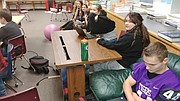New approach to learning benefiting St. Regis students
Educational innovation is often thought to be the product of large schools in large cities.
But a three-pronged approach to creating an enhanced learning environment while at the same time helping students prepare for the working world is paying dividends at St. Regis High School. And as a result, the school is on track to meet or exceed state standards for ACT scores, the testing tool which assesses students who wish to pursue higher educational goals.
With the help of a federal grant, administration and staff at St. Regis High, led by Superintendent Joe Steele, have implemented unique approaches to learning including personalized learning, an Employability Scale and a goal of going beyond the ACT standards.
“The whole staff has put in a lot of work on these concepts,” Steele said. “We took a hard look at what were our existing approaches and materials and found they were not as effective as they should be. We formed a leadership team, reassessed things and moved forward on a data-driven basis.”
As is often the case with new concepts, Steele said, there were initial concerns. Many parents worried the computer based programs and data keeping instruments would mean even more time in front of their childrens’ computers.
“It was a struggle until last year,” he said. “These ideas created a lot of changes in the traditional approach, we had to weather the storm. But progress has been made and more people have come around.”
The concerns over students spending too much time on cell phones and other personal electronic devices, for example, was found to be at least partially responsible for the lower than standard ACT scores in writing.
Many students it was learned, had developed a form of “shorthand” generated by the many abbreviations and acronyms associated with texting.
The personalized learning approach allows students to see on-line what their course outlines are for the year and also allows them to select related subjects and “projects” that they can work on to add to their learning experience at their own pace. It also allows students and teachers to track progress in learning that may require additional effort and help.
Jeff Stanek, a social studies teacher at the high school, likes the new approaches.
“I think it gives students and teachers a lot of flexibility,” Stanek said. “It’s a platform that is catered toward given students more ways to complete assignments.”
Stanek said teachers also have more ways to be creative and flexible in implementing their teaching approach and lesson planning.
“As a teacher this gives me more freedom to add learning projects in line with guidelines set by Montana education standards,” he said.
When coupled with daily lectures on the subjects at hand it also allows teachers to work ahead on their own goals, Stanek added.
Ian Farris, a senior in Stanek’s social studies class agreed.
“Overall I like it,” Farris said. “It gives me more control over learning. I can focus on what needs to be done and when, and I can look ahead.”
Steele said the program’s features allow students to go above and beyond what would be considered required achievement. As proof, he noted that three eighth grade students, having mastered learning requirements for eighth graders, now spend approximately half their day doing ninth grade course work.
The Employability Scale concept adds another educational layer to students who will one day be entering the workforce. Records are kept and points are awarded for things like being on time, high attendance and accountability with finishing assignments. The scores are available to students to take to potential employers as another tool to help them get a job. And incentive to improve in those areas as needed.
“We are trying to convince students that employers are among other things looking more and more at basic skills including can you get to work on time, can you be here regularly and do you get along with others,” Steele said.
Superintendent Steele said the programs are unique to Montana high schools. “It’s the only program like it,” he said. “Other schools have sent representatives to look at our approach and how we accomplished it.”
Good things, as they say, often come in small packages.



